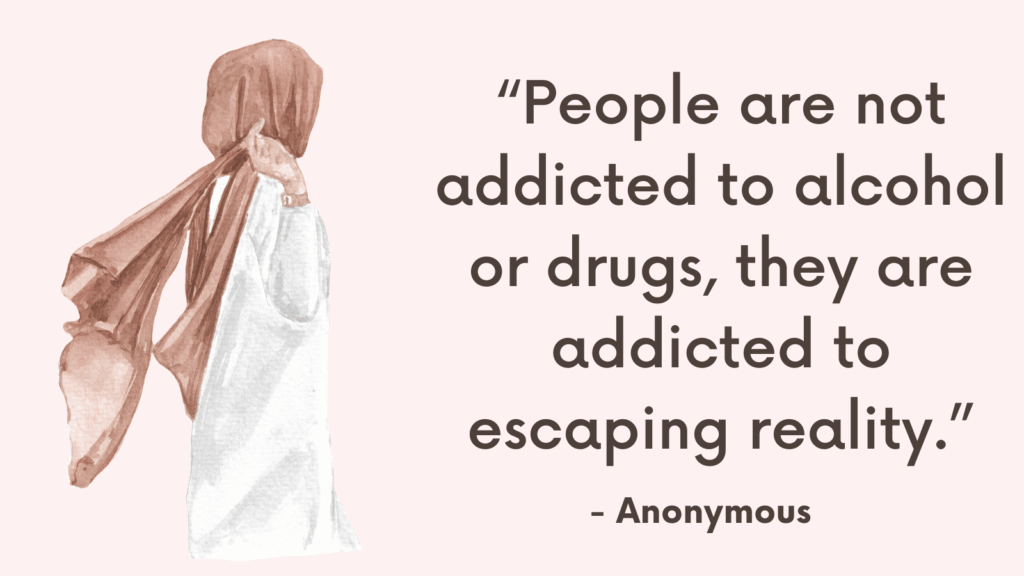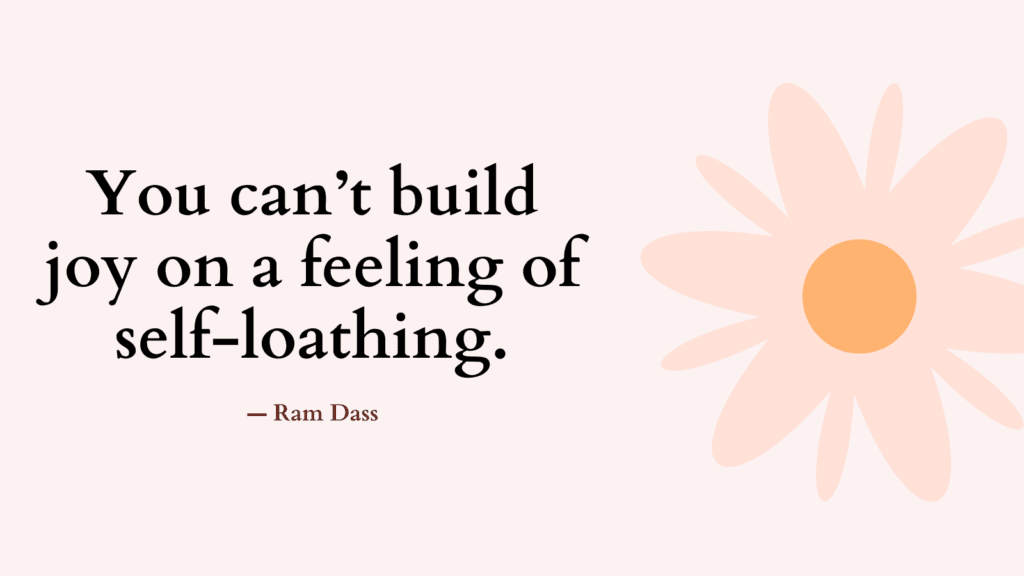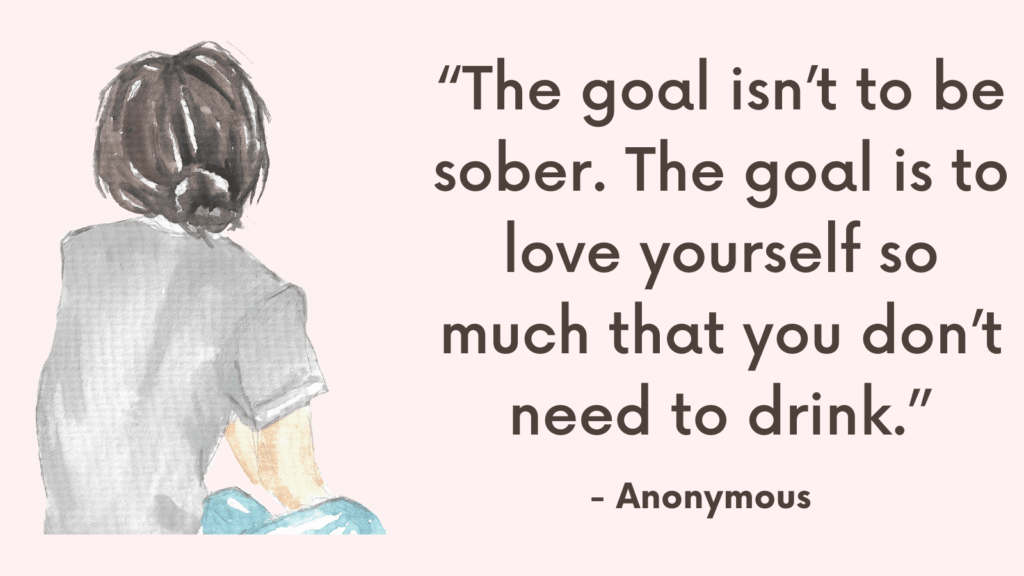Today, you’re going to find out what emotional sobriety is and learn how to achieve it and stop replacing one addiction with another using a powerful 8-step guide to successfully move on after addiction.
The most challenging part about overcoming addiction isn’t stopping self-destructive behaviors or abstinence.
It’s putting an end to cravings and finding the courage to address underlying issues – emotional sobriety.
Without emotional sobriety, you’ll find yourself constantly replacing one addiction with another.
Emotional sobriety refers to the ability to be present with all of your feelings without any one of them defining or controlling you.
Addictions and out-of-control behaviors are really about numbing pain and coping with it. The remedy is learning healthy coping mechanism that will get you through that pain.
The Goal Isn’t Abstinence, But Facing Underlying Issues
The quest for emotional sobriety is an incredible growth opportunity.
Emotional sobriety requires an internal shift—a conscious choice to live fully and move forward without self-sabotage.
The goal of overcoming addiction isn’t to forever quit whatever addictive behavior you struggled with, especially when the behavior in itself isn’t unhealthy like work, relationships, exercising, etc.
As you heal from out-of-control behaviors, over time you can introduce safer, healthier forms of that behavior into your life and use it in a healthy way.
Temporary periods of abstinence from addictive behaviors are necessary to address underlying issues, but in the long run, it’s more realistic and productive to gradually integrate that behavior into your life again, that is when it can be used in a healthy way.
What Is Emotional Sobriety?
What exactly is emotional sobriety?
Emotional sobriety is the capacity to experience life fully with a resilient, resourceful state of well-being.
You’re emotionally sober when you feel comfortable in your own skin and at peace with who you are.
It is when you feel most like yourself. That could include expressing yourself in a creative way, feeling connected with nature, feeling connected with your inner self, feeling connected with loved ones, etc.
Emotional sobriety includes the ability to:
- regulate strong emotions, mood, and potentially harmful behaviors,
- maintain a perspective on life circumstances,
- live in the present, living with deep,
- have intimate connection, and
- develop resilience – the capacity to recover quickly from setbacks.
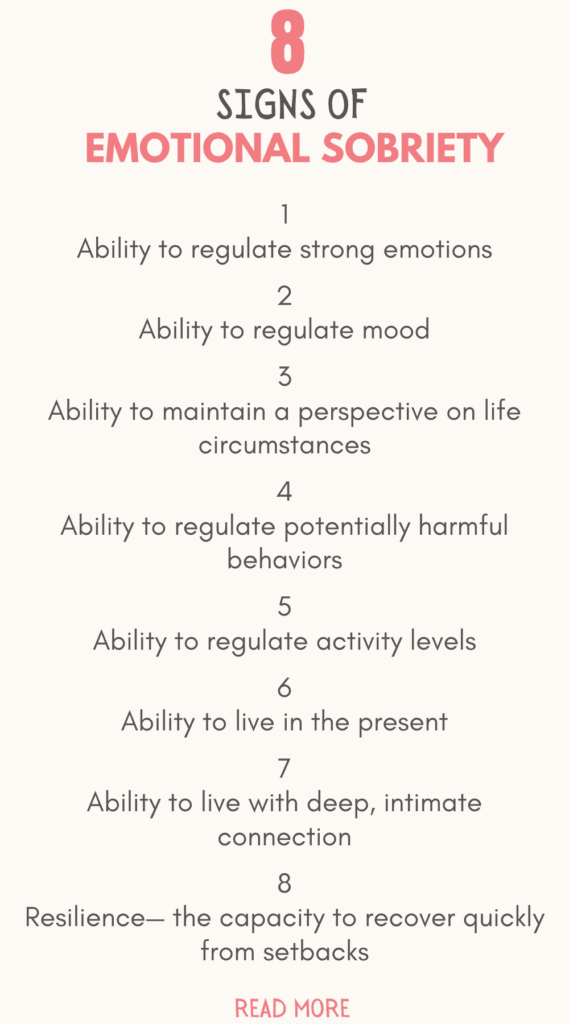
Self-Regulation
“Regulation” refers to the way you achieve internal well-being to feel balanced, resilient, and most like yourself.
Dysregulation occurs when painful emotions become more powerful than your ability to calm yourself.
How do you regulate your intense emotions more effectively?
Learning to regulate your nervous system is a lifelong practice, but strategies such as deep breathing, mindfulness, and asking for help and support can help you find your way back to a regulated state.
If you’re still struggling to quit your addiction, start by reading this blog post: How to Stop an Addiction? 15 Actionable Steps To Help You Stop Any Addiction For Good
FREE Emotional Sobriety Worksheets
How To Achieve Emotional Sobriety Using Powerful 8-Step Guide?
Step 1. Find Your Tribe
Recovery doesn’t happen in isolation.
If anything, isolation can worsen your issue, especially when you’re recovering from a substance use disorder.
Although we can be independent adults when it comes to our happiness, growth, and even survival, it’s essential to be interdependent.
Interdependence is the ability to be mutually reliant on each other.
A growing body of research supports the benefits of connection as it relates to our mental health. (*)
In addiction recovery, interdependence is achieved when you connect with others who are on the same path, and those who have already achieved recovery.
This is why 12-Step programs and other types of support groups are so effective.
Step 2. Turn down the Volume on Shame
When a wrongful action is not processed fully, it registers as a character defect and you begin to experience shame, be it an emotion or a thought.
The terms shame and guilt are often used interchangeably, but there’s a difference – You feel guilt for what you do; you feel shame for who you are.
Because addictions are incongruent with your personal values, you can feel a profound shame about yourself, leaving you at risk for further acting out.
To heal toxic shame you need to come out of hiding. We cannot change our “internalized” shame until we “externalize” it.
Related: 10 Signs You Were Shamed In Childhood
Coming Out of Hiding and Isolation
In order to be healed, you need to come out of isolation and hiding and connect with others.
When you trust someone else and experience their love and acceptance, you begin to change your beliefs about yourself and learn that you are not bad, that you are lovable and acceptable.
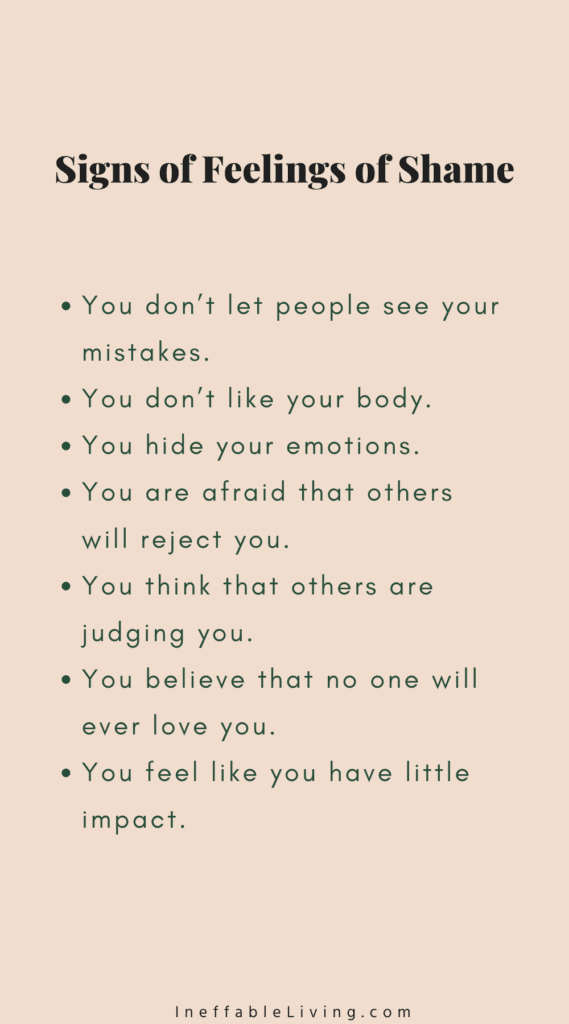
Step 3. Confront and Change Your Toxic Inner Voices
The best way to change your inner voice is through externalization.
When you verbalize or write down your negative self-talk, intense feelings are released and you become able to examine these thoughts and challenge their validity.
Related: 6 Powerful Techniques To Stop Spiraling Negative Thoughts from Taking Control
Practical Exercise 1 – Keeping An “Overreaction Journal”
One of the best ways to examine your negative beliefs about yourself is to keep a journal of your defensive overreactions.
Each evening before going to bed, think back over the events of the day, and ask yourself the following questions:
Where did I overreact? What was the context? What was said to me? How does what was said to me compare with what I tell myself?
Practical Exercise 2 – Answering The Voice
Once you’re aware of your negative self-talk, start challenging the voice.
When the voice tells you “you’re a bad parent,” argue back that, “I’m a loving parent and I’m trying my best, and that’s good enough.”
Repeating this process, day after day will help you change your inner voice, from critical, to compassionate.

Step 4. Practice Self-Compassion
One of the most difficult processes of addiction recovery is learning how to forgive yourself and other people.
While it’s natural for us to experience feelings of anger, hate, judgment, and resentment from time to time, we don’t have to harbor and hold onto these feelings.
Most people who struggle with addiction, are engaged in an abusive relationship with themselves. As they recover from their addiction, it’s common to experience a significant degree of shame and self-loathing, which can lead to relapse when left unaddressed.
If you’re struggling to get or remain sober, refrain from criticizing yourself, calling yourself names in your own mind, or shaming yourself in any way.
Shame is a toxic emotion because it attacks the person’s sense of self. Guilt, on the other hand, is a healthy emotion because it focuses on the behavior rather than the person.
While guilt comes with thoughts like “I made a mistake,” shame comes with thoughts like, “I am a mistake,” which only serves to intensify addiction issues and other forms of self-harm.
To release shame, start practicing compassion and forgiveness toward yourself and others.
1. Forgiveness and Gratitude
Forgiveness is not about letting someone off the hook, forgetting, or making what happened okay.
To forgive is to stop wishing the past was different, to recognize the harm we are doing to ourselves by not forgiving and holding on to the anger and resentment, and to release those feelings.
Try This
1. Sit in a comfortable position where you won’t be disturbed.
2. With your eyes closed, bring your attention to your breathing. This will help quiet the mind and relax the body.
3. Once relaxed, pick someone you are feeling any resentment toward and picture them in your mind. Visualize them standing across from you and say to them, “Please, forgive me.”
That’s right. You are going to ask the person who you feel resentment toward, to please forgive you.
4. Next, you’re going to picture yourself and follow the same process, and you’re going to ask for forgiveness from yourself.
5. Finally, after releasing the resentment, you are going to shift your feelings and focus on all the things you’re grateful for in your life. Focus on the feeling of gratitude for a few minutes.
If you are religious, you may find the Resentment Prayer technique helpful. This is a process whereby you pray for the person you feel resentment toward and you pray that they may receive all the things that you would wish for yourself.
You may find yourself resistant at first. It is okay, the goal here is to try and practice with an attitude of curiosity and notice how you feel.
2. Self-Compassion
Unless we are able to be self-compassionate, we cannot truly extend that compassion to others.
Self-compassion is not about suppressing your difficult emotions. It is about learning how to move through them quickly in a healthy way.
Try This
1. Choose an experience that triggers shame you’ve had in the past and write about it, stating the facts, without judgment.
2. Imagine a dear friend has been through that same experience. Imagine what you’d tell him to ease his feelings of shame.
3. Now extend that compassion to yourself and tell yourself the same thing.
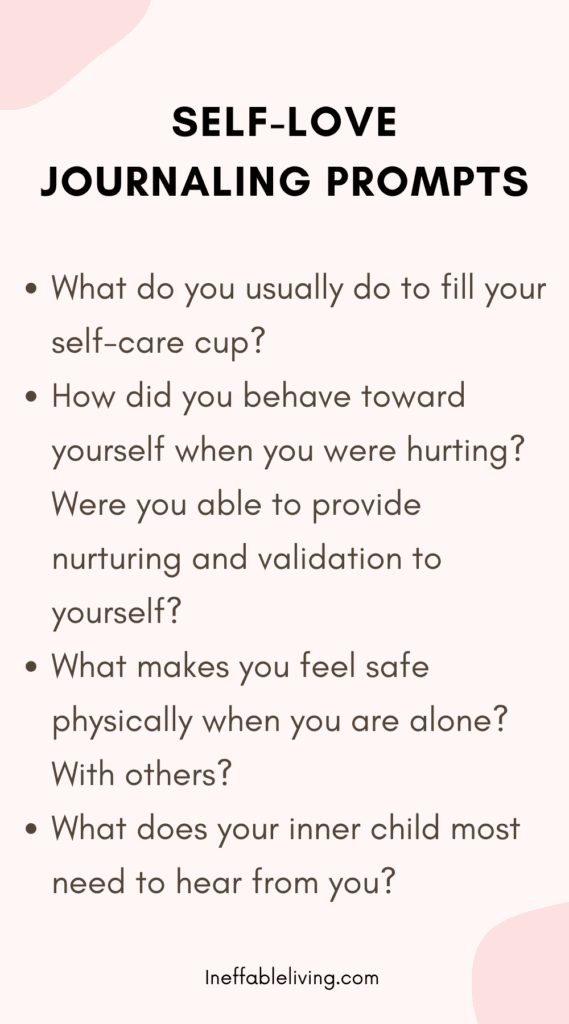
Step 5. Move Beyond Self-Centeredness
Addiction is an all-consuming activity. When consumed by your impulses, nothing else seems to matter. It’s an exercise in self-absorption.
1. Understand Toxic Self-Centeredness
It’s okay to be selfish at times, to set healthy boundaries in your relationships, and to take care of yourself.
But in recovery, it helps to find a balance between our self-care and giving back to others, as you learn to connect with them and share a deeper sense of intimacy.
When you’re consumed by sexual obsessions, you unintentionally become self-absorbed. Immediate gratification becomes your sole focus and you begin to avoid real contact with others.
2. Give More to Your Relationships
Because of your addiction, you might have attracted partners with codependent tendencies who act selflessly and use taking care of others as the main way to feel valued.
In order to move beyond self-absorption and enjoy healthy relationships, you need to pursue your partner more, by initiating affectionate acts more.
3. Being of Service
Service to others is one of the themes of twelve-step programs, and that’s for a very good reason.
Other-centeredness helps you get out of your head and gives your mind something else to do – something healthier and more constructive.
Start by offering people help and finding new opportunities to help and perform acts of kindness.
Step 6. Start Living in the Moment
Living in the moment means to mindfully notice the present, for one.
When you’re present, you get in deeper contact with yourself —with your mind, body, and emotions.
Rather than attempting to escape your emotions by numbing them using addiction, you choose to feel them – to receive their message and feedback.
Emotional pain, like physical pain, sends a powerful signal that something is wrong, nudging you to take action of some kind. Perhaps, you need to let go of some toxic relationships, quit your job, or remove a disempowering story that creates suffering in your life.
Instead of withdrawing, or distracting yourself from your painful emotions, choose to face them and process them in a healthy way.
The following strategy can help with that:
Mindfulness strategies
Some of the best indicators of the emotions we’re experiencing are our physical signals. By tuning in to your physical sensations, you can develop greater awareness of your emotions.
1. Take a few moments to be still and enter the world of being rather than doing.
2. Begin this exercise by focusing on your breath and feeling into your body and mind and simply allowing any thought, emotion, or physical sensation to just be.
3. You don’t need to judge, analyze, or figure things out. Spend about three minutes simply checking in with yourself.
Apps like The Mindfulness App, Headspace, Calm, and buddhify can help introduce you to mindfulness and silent meditations.
Breath Work Exercise
1. Try doing this exercise lying down on the ground and notice how that provides a sensation of being grounded to the earth.
2. Place one hand on your stomach and the other on your heart.
3. Inhale deeply through your nose as you silently count to three.
4. Exhale through your mouth as you silently count to six.
5. Repeat this six more times, and then see if you can work up to a four-count inhale, followed by an eight-count exhale, and then five-count inhale, followed by a ten-count exhale.
Once you’re done, notice how you feel calmer and more present.
Apps like Prana Breath, MindShift CBT, Breath Ball, and Health through Breath can help make breathing exercises easier.
Journaling: Identify Your Primary Emotion In A Distressing Situation
In your journal write answers to the following questions:
1. What happened?
Describe the situation that triggered your emotions. Write down what happened, when and where, who was involved, and so on.
2. Why do you think that situation happened?
Identify the potential causes of the situation. Do you think the other person hurt you on purpose?
3. How did the situation make you feel emotionally and physically?
Try to identify the body sensations you experienced, such as muscle tension, and the emotions you felt during the situation and afterward.
This is a list of common emotions that can help you name your intense emotions.
Afraid, Angry, Annoyed, Anxious, Apologetic, Ashamed, Bored, Disgusted, Disturbed, Embarrassed, Empty, Enraged, Envious, Exhausted, Frightened, Frustrated, Guilty, Hopeless, Horrified, Hurt, Hysterical, Indifferent, Irritated, Jealous, Lonely, Mad, Nervous, Regretful, Restless, Sad, Scared, Surprised, Suspicious, Terrified, Tired, Unsure, Upset, Vulnerable, Worried
4. What did you want to do as a result of how you felt?
Often, when a person is overwhelmed with emotions, they have the urge to say or do something that is hurtful but might not act on these impulses.
Notice what you wanted to do and compare it with what you actually ended up doing.
5. How did your emotions and actions affect you later?
Consider the consequences of what you felt and did. If you ended up acting on your impulses, was it worth it? Did it make you feel better? If not, what would a better option have been?
Soothing Yourself
Here are a few specific grounding rituals for when you experience intense emotions:
- Visualize a happy memory, a pleasant place (if necessary, use a photo).
- Ask your Higher or Universal Power for the guidance to do what is necessary to change your attitude.
- Try laughter therapy. Watch something funny or read a funny story.
- Listen to soothing music.
- Practice nurturing self-talk
- Spend time with a loved one, or a pet
Related: Getting Started with Mindfulness: 6 Simple Mindfulness Practices for Daily Life
Step 7. Be Aware of The Post-Acute Withdrawal Phase
The effect of addiction remains strong and powerful within the brain and the body for a very long time.
You may start feeling good physically after detox, but that’s not enough in order to stay sober and prevent relapse.
It’s not until you overcome the underlying issues of your addiction and learn new, healthier ways to cope with pain and difficult emotions that you will begin to make any true progress in weakening the addiction and reclaiming your strength.
Post-acute withdrawal phase is a phase that occurs within your body as your brain continues to heal and after the acute withdrawals subside.
This phase can take up to 2 years during which symptoms will be intermittent, and will only last for a day or two at a time.
Common symptoms of Post-Acute Withdrawal Syndrome include irritability, stress sensitivity, sleeplessness, anxiety, depression.
The symptoms generally occur seemingly out of the blue, after a time when you have been feeling really good. If you’re not aware of these symptoms, you may relapse.
During this time, it’s important to take care of your physical health. What you put in your body is as important as what you do not put in it.
Proper nutrition, good sleep, and regular exercise can help you move through the post-acute withdrawal symptoms more quickly and reduce the risk of relapse.
Withdrawal from substance addiction, alcohol, in particular, may cause seizures. This is one of the reasons it’s so important to be medically monitored during this phase.
1. Get Moving
Physical activity provides benefits that go way beyond extending your lifespan.
Regular physical activity improves the quality of your life dramatically. It helps to reduce your risk of type 2 diabetes, metabolic syndrome, and heart disease. It also helps to strengthen your bones and muscles and boost your mood.
Exercise is one way to become physically active, but the change is about becoming mindful of opportunities for activity and opting to move.
These small choices can add up to make a big difference:
- Commuting: If it’s less than a 30-minute walk, walk it. Or park farther if you’re not in a hurry.
- Walking the dog: If you don’t have a dog, offer to walk your neighbor’s dog or volunteer as a dog walker at services, such as Underdog international, Blue Cross for Pets, Paws.org, etc.
- At Work: Take breaks to stretch or walk to a colleague’s office down the hall rather than calling him on the phone. Use the stairs instead of the elevator.
- Cardio: Go to the gym or buy equipment to exercise at home like a stationary bike, a cross-trainer, or even a treadmill.
- Floor Exercises: If you don’t want to spend money on cardio equipment or don’t have space for it, you can easily do some exercises on the floor like sit-ups or push-ups, or even a 7-minute exercise from a YouTube video or an app.
2. Eat Moderate-Sized, Healthy Meals
A healthy meal should be rich in color (including many vegetables) and include no processed foods, no sugar or additives (such as artificial sweeteners, aspartame, or msg).
If you’re still wondering what to eat, the Mediterranean diet has been shown to be beneficial. For supplements, most available over-the-counter multivitamins are sufficient as daily supplements. (*)
3. Drink Enough Water
Replenishing your body on a daily basis is vital to proper body function. It helps to carry nutrients to your cells and is important in digestion and flushing toxins from your system. It keeps the blood clean and the skin soft and stretchy.
Drink additional ounces of water for the following situations:
- Exercise: An extra eight ounces of water for every twenty minutes of exercise.
- Travel: An additional eight ounces of water for every hour on a flight.
- Climate: An additional sixteen ounces of water if you live in a dry climate.
- Breast-feeding: An extra eight ounces of water prior to each feeding.
- Pregnancy: An extra eight ounces of water.
In general, a good rule of thumb is to drink enough water so you’re your urine is pale and doesn’t smell strong.
- Space out your dose of water. Drink an eight-ounce glass of water every hour.
- Drink a glass of water before every meal. It will fill you and prevent you from overeating.
- If you find plain water unpalatable, try adding a squeeze of lemon or a slice of cucumber.
- To reduce plastic waste, filter your tap water and fill a reusable water bottle that you carry around with you.
4. Get Enough Sleep
Proper sleep helps to strengthen the immune system, boosts cognitive function and memory, and helps us to look and feel our best.
Lack of sleep, on the other hand, causes irritability and moodiness, decreased attention span, fatigue, and headaches. Long-term effects of lack of sleep include slowed metabolism, which leads to weight gain or diabetes, increased blood pressure, impaired memory, and depression.
Here are some tips to ensure you get enough sleep every night:
- Lights: Keep your bedroom dark and use nightlights in hallways and bathrooms.
- Sound: If you can’t isolate your room from the noise, purchase a white noise machine to help mask the noise or use earplugs.
- Linens and Sleepwear: Use quality linens on your bed and sleep in comfortable sleepwear.
- Humidity: Use a humidifier if your room is too dry and a dehumidifier if your room is extremely humid.
- Create a Bedtime Ritual: This will prepare your body and your mind for sleep. A bedtime relaxation ritual can include a bedtime tea, a bath, reading fiction, journaling, etc.
- Eating: Don’t eat at least two hours before bedtime to avoid the risk of being kept up by an active digestive tract. Make sure your dinner is well balanced, and not too high in fat or simple carbohydrates (sugars and foods made with refined flour) and avoid eating foods that cause acid reflux, or excessive gas, or any other discomfort.
- Fluids: To avoid having to run to the bathroom several times during the night, make sure you avoid drinking a lot of liquid two to three hours before bedtime.
Pro Tip: Fall asleep faster with Amber light. SOMNILIGHT offers a wide range of products that blocks blue light and help you fall asleep up to an hour faster. Use this link to receive a coupon code for 10% off any purchase. (Free U.S. shipping and 60-day money back guarantee.)
Step 8. Harness The Healing Powers of Spirituality
Although religion can be one way to practice spirituality, it is not the only way.
In a general mental health context, spirituality has been defined as “a process of promoting opportunities to build meaningful personal connections, whether these are with oneself, others, nature, or a higher power ” (Subica & Yamada, 2017).
1. Spiritual Beliefs
Spirituality begins with beliefs. Do you believe in God? Do you believe in a universal power? Do you believe in the power of nature? Do you not believe in any kind of a higher power? What do you believe?
2. Spiritual Practices
Religion is not the only way to practice spirituality.
There are many ways to practice spirituality that exist outside of religious practice.
Nature – For many individuals, nature represents a way to connect to a higher power. The Sun can be thought of as one big ball of power. The earth can provide a feeling of calm and peace.
Self-Expression – Creating, writing, singing, and other forms of self-expression are how many people feel most spiritual. Some would describe it as the feeling of being connected to a flow within themselves.
Relationships – many people feel most spiritual through intimacy – when they’re communicating heart to heart with another person.
Relationships are also a way to make a difference in someone else’s life, which is a way to practice spirituality.
Within Body – Practices such as exercising, martial arts, meditation, yoga, and other relaxation practices are also a great way to feel connected within yourself or to something greater than yourself.
Mistakes Don’t Define You
The way to emotional sobriety is strengthened by self-forgiveness.
As humans, we’re imperfect. And mistakes serve a purpose – to get you to slow down, self-reflect, and learn valuable lessons that will make you a better person.
The key to forgiving yourself is to learn and move on from your mistakes.
Being able to forgive yourself requires compassion and understanding. It also requires you to accept that forgiveness is a choice.
FAQ
Can Quitting Alcohol Make You Depressed?
Alcohol is often used by people to numb their painful emotions.
It’s only natural that quitting alcohol will make you have no choice but to face those painful feelings.
You might be wondering then, what’s the point of quitting alcohol if being sober means feeling worse?
But post-alcoholic depression is temporary when addressed properly.
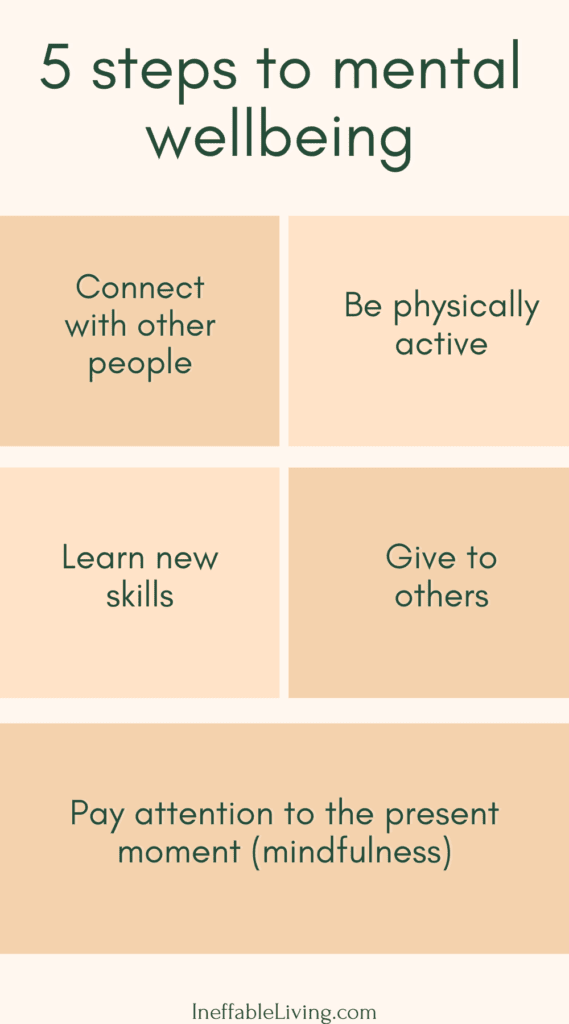
References
- Portions of this article were adapted from the book It’s Not About the Sex: Moving from Isolation to Intimacy After Sexual Addiction, © 2019 by Andrew Susskind. All rights reserved.
- Portions of this article were adapted from the book The Warrior’s Guide to Successful Sobriety, © 2019 by K. J. Foster. All rights reserved.
- The Nuts and Bolts of Emotional Sobriety – Scientific American
- How To Achieve Emotional Sobriety – Cleveland Clinic
- What Is Emotional Sobriety? | Psychology Today
- What Is Emotional Sobriety? How To Use This Self-Growth Tool (womenshealthmag.com)
